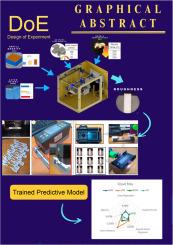3D打印部件垂直方向测量表面粗糙度预测的机器学习驱动优化
IF 6.5
Q2 ENGINEERING, ENVIRONMENTAL
引用次数: 0
摘要
在增材制造(AM)中,表面粗糙度精度可能具有挑战性,因为传统的基于点的测量通常无法捕获全部表面特征。本研究探讨了机器学习(ML)如何通过将基于图像的分析与实时自适应控制相结合来改善粗糙度预测。全因子实验设计考察了填充密度、打印速度、喷嘴温度和层高对垂直定向打印部件表面粗糙度的影响。使用包括粗糙度图像数据在内的81个实验数据集来测试和验证XGBoost模型。该模型优于传统回归方法,R2为97.06%,均方误差(MSE)为0.1383,而传统回归方法的R2为95.72%,MSE为0.224。这些结果证明了机器学习驱动的优化在显著提高增材制造、航空航天、医疗保健和汽车行业的精度和一致性方面的潜力。本文章由计算机程序翻译,如有差异,请以英文原文为准。

Machine learning-driven optimization for surface roughness prediction of vertical orientation measurements on 3D printed components
Surface roughness accuracy can be challenging in Additive Manufacturing (AM) because traditional point-based measurements often fail to capture the full range of surface characteristics. This study investigates how machine learning (ML) can improve roughness prediction by integrating image-based analysis with real-time adaptive control. A full factorial experimental design examines the effects of infill density, print speed, nozzle temperature, and layer height on the surface roughness of vertically oriented printed parts. A dataset of 81 experiments, including roughness image data, is used to test and validate the XGBoost model. The proposed model outperforms traditional regression methods, achieving an R of 97.06% and a Mean Squared Error (MSE) of 0.1383, compared to 95.72% and 0.224 of the conventional approach. These results demonstrate the potential of ML-driven optimization to significantly improve precision and consistency in AM, aerospace, healthcare, and automotive industries.
求助全文
通过发布文献求助,成功后即可免费获取论文全文。
去求助
来源期刊

Cleaner Engineering and Technology
Engineering-Engineering (miscellaneous)
CiteScore
9.80
自引率
0.00%
发文量
218
审稿时长
21 weeks
 求助内容:
求助内容: 应助结果提醒方式:
应助结果提醒方式:


